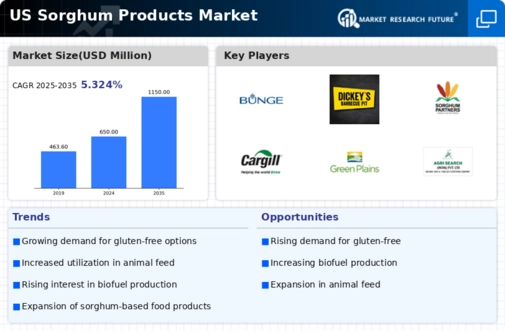Health Benefits of Sorghum
The health benefits associated with sorghum consumption are increasingly recognized, driving growth in the sorghum products market. Sorghum is rich in dietary fiber, antioxidants, and essential nutrients, which appeal to health-conscious consumers. As awareness of gluten intolerance rises, many individuals are turning to sorghum as a nutritious alternative to wheat and other gluten-containing grains. The sorghum products market is witnessing a surge in demand for whole grain sorghum, flour, and snacks, which are perceived as healthier options. According to recent data, the market for gluten-free products is projected to grow at a CAGR of 9.5% through 2026, indicating a strong potential for sorghum-based products. This trend suggests that the health benefits of sorghum could significantly influence consumer purchasing decisions, thereby enhancing the overall market landscape.
Sorghum as a Sustainable Crop
Sorghum's reputation as a sustainable crop is becoming a pivotal driver for the sorghum products market. With its ability to thrive in arid conditions and require less water than other grains, sorghum is increasingly viewed as an environmentally friendly option. The sorghum products market is likely to benefit from the growing consumer preference for sustainable and eco-friendly food sources. As agricultural practices shift towards sustainability, sorghum's low input costs and resilience to climate change make it an attractive choice for farmers. Recent studies suggest that sorghum cultivation can reduce greenhouse gas emissions by up to 30%, further enhancing its appeal. This sustainability narrative is expected to resonate with consumers, potentially leading to increased demand for sorghum-based products in the coming years.
Rising Ethnic Cuisine Popularity
The increasing popularity of ethnic cuisines in the United States is contributing to the expansion of the sorghum products market. As consumers become more adventurous in their culinary choices, they are exploring diverse ingredients, including sorghum, which is a staple in various traditional dishes. The sorghum products market is benefiting from this trend, as chefs and home cooks alike incorporate sorghum into recipes for its unique flavor and texture. Additionally, the rise of food blogs and cooking shows featuring ethnic cuisines has further fueled interest in sorghum-based dishes. Market data indicates that the ethnic food market is expected to grow by 12% annually, suggesting a favorable environment for sorghum products to gain traction among consumers seeking authentic culinary experiences.
Innovations in Sorghum Processing
Innovations in processing techniques are playing a crucial role in shaping the sorghum products market. Advances in technology have enabled the development of new sorghum-based products, such as gluten-free flours, snacks, and beverages, which cater to evolving consumer preferences. The sorghum products market is witnessing a wave of product innovation, with manufacturers exploring novel ways to enhance the taste, texture, and nutritional profile of sorghum. For instance, the introduction of sorghum-based protein powders is appealing to the growing segment of health-conscious consumers and athletes. Market analysis indicates that the functional food sector is projected to grow by 8% annually, suggesting that innovative sorghum products could capture a significant share of this expanding market.
Government Support for Sorghum Production
Government initiatives aimed at supporting sorghum production are emerging as a key driver for the sorghum products market. Various agricultural policies and subsidies are being implemented to encourage farmers to cultivate sorghum, recognizing its potential as a versatile crop. The sorghum products market stands to benefit from these supportive measures, which may include financial incentives, research funding, and educational programs for farmers. Recent reports indicate that the U.S. Department of Agriculture has allocated $10 million to promote sorghum research and development, highlighting the government's commitment to enhancing sorghum production. This support is likely to bolster the supply chain, making sorghum more accessible to consumers and manufacturers, thereby fostering growth in the market.

















Leave a Comment